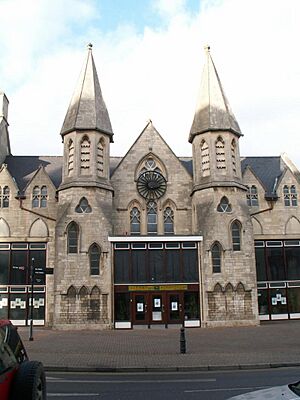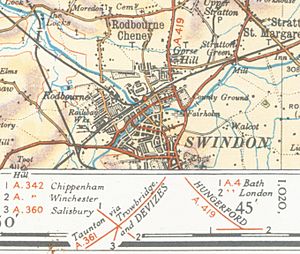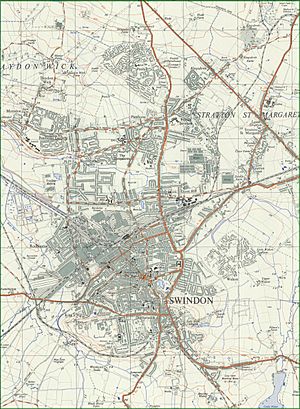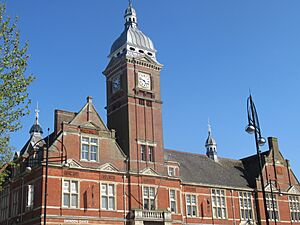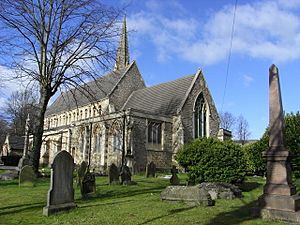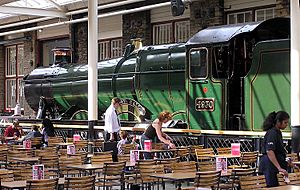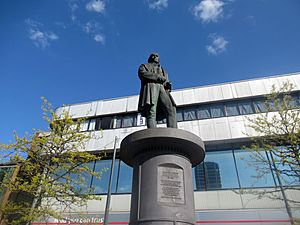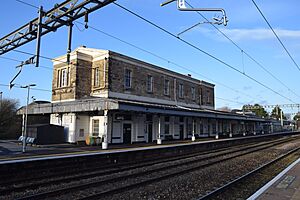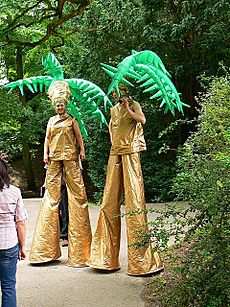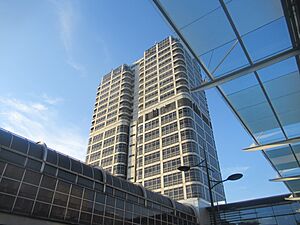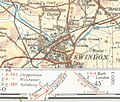Swindon facts for kids
Quick facts for kids Swindon |
|
|---|---|
| Town | |
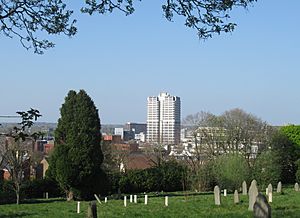 Central Swindon seen from Radnor Street Cemetery in 2019 |
|
| Population | 183,638 |
| OS grid reference | SU152842 |
| • London | 71 miles (114 km) |
| Unitary authority |
|
| Ceremonial county | |
| Region | |
| Country | England |
| Sovereign state | United Kingdom |
| Post town | SWINDON |
| Postcode district | SN1–SN6, SN25, SN26 |
| Dialling code | 01793 |
| Police | Wiltshire |
| Fire | Wiltshire |
| Ambulance | Great Western |
| EU Parliament | South West England |
| UK Parliament |
|
Swindon is a lively town in Wiltshire, England. In 2021, about 183,638 people lived here, making it the biggest town in the county. Swindon is located in South West England, about 71 miles (114 km) west of London. It's also 36 miles (57 km) east of Bristol.
Swindon is mentioned in the 1086 Domesday Book as Suindune. The town changed a lot when the Great Western Railway arrived in 1843. It grew from a small market town into a huge railway center. At its busiest, it was one of the largest railway engineering places in the world.
The railway brought amazing new things to Swindon. It had the UK's first ever lending library. It also had a special healthcare center that looked after people from birth to old age. This center was later used as a model for the NHS, which provides healthcare for everyone in the UK.
Today, you can still see Swindon's railway past. Visit the grade 2 listed Railway Village or the STEAM Museum. The McArthurGlen Designer Outlet is even built inside the old railway works buildings! Many places in Swindon are named after Isambard Kingdom Brunel, the famous engineer who helped bring the railways to town.
Even after the railway works closed, Swindon kept growing fast. It became one of the fastest-growing towns in Europe after World War II. Many big international companies moved here because of its growing population and good transport links.
Swindon has cool places like the Wyvern Theatre and the Mechanics' Institute. Lydiard Park has hosted big events like BBC Radio 1's Big Weekend. The Swindon Mela is a fun festival celebrating South Indian arts and culture. It attracts up to 10,000 visitors every year.
Near Swindon, you can find ancient sites. The Ridgeway is known as Britain's oldest road. Avebury has the world's largest megalithic stone circle. And the Uffington White Horse is Britain's oldest white horse figure carved into a hillside.
Swindon is also home to Swindon Town F.C., Wiltshire's only professional football club. They even played in the Premier League in 1993-94! They famously beat Arsenal in the 1969 League Cup final. Today, they play in League Two at the 15,000-seat County Ground. Other sports teams include the Swindon Wildcats Ice Hockey team and the Swindon Robins speedway team.
Contents
- Swindon's Story
- How Swindon is Governed
- Swindon's Location and Landscape
- People of Swindon
- Places to Worship
- Swindon's Economy
- Getting Around Swindon
- Fun Things to Do in Swindon
- Media in Swindon
- Learning in Swindon
- Museums and Cultural Spots
- Sports in Swindon
- Famous People from Swindon
- Sister Cities
- Images for kids
- See also
Swindon's Story
How Swindon Began
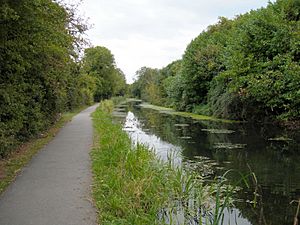
The first settlement in Swindon was built by the Anglo-Saxons on top of a limestone hill. In the Domesday Book of 1086, it was called Suindune. This name probably comes from old English words meaning "pig hill."
Swindon was a small market town where people traded goods. This original market area is now called Old Town. It's on top of the hill in central Swindon.
Swindon started to grow much faster during the Industrial Revolution. This began when the Wilts and Berks Canal was built in 1810. The North Wilts Canal followed in 1819. These canals brought more trade to the area, and Swindon's population increased.
The Railway Town
Between 1841 and 1842, Isambard Kingdom Brunel's Swindon Works was built. This was a huge factory for fixing and maintaining trains for the Great Western Railway (GWR). The GWR also built a small village nearby to house its workers.
Today, parts of the old works are home to the Steam Railway Museum and English Heritage. The railway village had important places like the GWR Medical Fund Clinic and a hospital. In 1892, a health center opened with clinics, a pharmacy, laundries, baths, and swimming pools.
From 1871, GWR workers paid a small amount from their wages into a healthcare fund. This fund provided free medicines and medical treatment for them and their families. In 1878, they even started making artificial limbs. Later, they opened a dental surgery. This amazing "cradle-to-grave" healthcare system was later used as a model for the NHS.
The Mechanics' Institute was started in 1844. It moved into a new building in 1855, which looked a bit like a church. This building also had a covered market. This group helped railway workers become some of the best-educated manual workers in the country.
The Institute had the UK's first lending library. It offered lectures, a theater, and many activities, from first-aid classes to music lessons. The Institute also helped create the New Swindon Co-operative Society in 1853, which ran a retail business. It also supported early trade unions and local democracy.
When a serious illness called tuberculosis spread, the Mechanics' Institute made sure that former railway employees still received medical care from the GWR Medical Society Fund.
Swindon had another railway called the Midland & South Western Junction Railway. This railway aimed to connect with other major lines. It ran into Swindon Town railway station in Old Town.
In 1900, the original market town (Old Swindon) joined with the new railway town. They became one single town.
On July 1, 1923, the GWR took over the M&SWJR. The line north from Swindon Town station was moved to Swindon Junction. The last passenger trains on the old line ran on September 10, 1961.
In the first half of the 20th century, the railway works was the town's biggest employer. It had over 14,500 workers. The writer Alfred Williams (1877–1930) wrote about his life working there.
The railway works started to decline in 1960. That year, they built Evening Star, the last steam engine made in the UK. The works stopped building locomotives and focused on maintaining other train parts. Most of the works closed in the late 1970s, and the rest closed in 1986.
The Community Centre in the Railway Village was originally barracks for GWR employees. It became the Railway Museum in the 1960s. The STEAM Museum opened in the 2000s.
Modern Swindon's Growth
David Murray John was Swindon's town clerk from 1938 to 1974. He helped a lot with Swindon's growth after World War II. His last act before retiring was to sign the contract for Swindon's tallest building, which is now named after him.
The closure of the railway works was a big challenge for Swindon. However, the town continued to grow and attract new businesses. This helped Swindon's economy become more diverse.
In February 2008, The Times newspaper called Swindon one of "The 20 best places to buy a property in Britain." This was because house prices were low compared to how much people earned.
In 2001, construction began on Priory Vale, a new part of Swindon's 'Northern Expansion' project. In 2002, the New Swindon Company was created to improve the town center. Their goal was to make Swindon more important in the region.
Swindon hosted Radio 1's Big Weekend in May 2009 at Lydiard Park. The town also organized the Big Arts Day for three years, celebrating different art forms.
In 2016, the Children's Fete was brought back to GWR Park. This event celebrates Swindon's children, community, culture, and history.
How Swindon is Governed
Swindon's local council was created in 1974. It was first called the Borough of Thamesdown. This was because it covered a larger area than just the town of Swindon. In 1997, it was renamed the Borough of Swindon.
On April 1, 1997, the borough became a unitary authority. This means it manages all local services itself, and is no longer controlled by Wiltshire Council.
Council elections are held in three out of every four years. One-third of the council seats are voted on each time. Starting in 2026, the whole council will be elected every four years. The Labour Party gained control of the council from the Conservatives in 2023. They increased their majority in 2024.
Swindon has two Members of Parliament (MPs) who represent it in the national parliament. Heidi Alexander (Labour) was elected for the Swindon South seat in July 2024. Will Stone, also Labour, represents Swindon North. This area covers the north of the borough, including Blunsdon and Highworth.
Swindon's Location and Landscape
The town of Swindon covers an area of about 40 square kilometers.
The landscape around Swindon has chalk hills called the Wiltshire Downs to the south and east. Old Town Swindon sits on a hill made of Purbeck and Portland stone. This stone was dug up from Roman times until the 1950s. The area known as New Swindon is mostly made of clay.
The River Ray starts at Wroughton and forms much of Swindon's western border. It joins the Thames, which forms the northern border. The source of the Thames is nearby in Kemble, Gloucestershire. The River Cole flows northeast from the town and forms the northeastern border.
- Nearby towns: Chippenham, Royal Wootton Bassett, Cirencester, Cricklade, Devizes, Highworth, Marlborough, Malmesbury, Calne
- Nearby villages: Aldbourne, Badbury, Blunsdon, Broad Hinton, Chiseldon, Hook, Lambourn, Liddington, Lydiard Millicent, Minety, Purton, Ramsbury, South Marston, Wanborough, Wroughton
- Nearby places of interest: Avebury, Barbury Castle, Crofton Pumping Station, Lydiard Country Park, Silbury Hill, Stonehenge, Uffington White Horse
- Sites of Special Scientific Interest in Swindon include Coate Water, Great Quarry, Haydon Meadow, Okus Quarry and Old Town Railway Cutting.
Swindon's Weather
Swindon has a mild climate, like the rest of the UK. Winters are usually mild, and summers are cool for its location. The closest weather station is at RAF Lyneham, about 10 km west-south-west of Swindon.
The highest temperature ever recorded was 34.9°C (94.8°F) in August 1990. On average, the warmest day each year reaches about 28.7°C (83.7°F).
The lowest temperature ever recorded was −16.0°C (3.0°F) in January 1982. On average, there are about 45 nights of frost each year.
Swindon gets about 1565 hours of sunshine a year. This is typical for southern England. The average rainfall is just under 720 mm per year. It rains more than 1 mm on about 123 days a year.
| Climate data for Lyneham, elevation 145m, 1971–2000, extremes 1960– | |||||||||||||
|---|---|---|---|---|---|---|---|---|---|---|---|---|---|
| Month | Jan | Feb | Mar | Apr | May | Jun | Jul | Aug | Sep | Oct | Nov | Dec | Year |
| Record high °C (°F) | 13.7 (56.7) |
16.6 (61.9) |
20.0 (68.0) |
25.3 (77.5) |
26.6 (79.9) |
32.7 (90.9) |
34.4 (93.9) |
34.9 (94.8) |
28.8 (83.8) |
26.5 (79.7) |
16.5 (61.7) |
14.4 (57.9) |
34.9 (94.8) |
| Mean daily maximum °C (°F) | 6.6 (43.9) |
6.9 (44.4) |
9.4 (48.9) |
12.0 (53.6) |
15.7 (60.3) |
18.5 (65.3) |
21.2 (70.2) |
20.7 (69.3) |
17.7 (63.9) |
13.6 (56.5) |
9.6 (49.3) |
7.4 (45.3) |
13.3 (55.9) |
| Mean daily minimum °C (°F) | 1.2 (34.2) |
1.0 (33.8) |
2.6 (36.7) |
3.7 (38.7) |
6.7 (44.1) |
9.7 (49.5) |
11.9 (53.4) |
11.8 (53.2) |
9.8 (49.6) |
6.8 (44.2) |
3.7 (38.7) |
2.1 (35.8) |
6.0 (42.8) |
| Record low °C (°F) | −16 (3) |
−11.3 (11.7) |
−8 (18) |
−4.8 (23.4) |
−1.6 (29.1) |
0.6 (33.1) |
3.8 (38.8) |
5.0 (41.0) |
1.5 (34.7) |
−3.6 (25.5) |
−7.8 (18.0) |
−14 (7) |
−16 (3) |
| Average precipitation mm (inches) | 70.1 (2.76) |
50.6 (1.99) |
58.3 (2.30) |
47.7 (1.88) |
51.8 (2.04) |
58.5 (2.30) |
47.2 (1.86) |
56.1 (2.21) |
63.9 (2.52) |
70.4 (2.77) |
66.9 (2.63) |
77.4 (3.05) |
719.0 (28.31) |
| Mean monthly sunshine hours | 55.2 | 72.3 | 108.5 | 156.9 | 196.2 | 194.1 | 212.4 | 197.5 | 144.6 | 107.3 | 71.7 | 48.4 | 1,565 |
| Source 1: Met Office | |||||||||||||
| Source 2: KNMI | |||||||||||||
People of Swindon
In 2011, the Swindon area had 209,156 people. By mid-2019, this number grew to an estimated 222,193.
In 2011, 57.5% of people in Swindon identified as Christians. This was down from 70% in 2001. About 31% said they had no religion. Other religions included Muslims (1.7%), Hindus (1.2%), Sikhs (0.6%), and Judaism (0.1%).
By 2021, 46.6% of Swindonians were Christian. Those with no religion increased to 40.5%. Muslims were 2.7%, Hindus 2.5%, Sikhs 0.6%, and Jewish people 0.1%.
In 2011, 16.7% of Swindon's population was non-White British. This is similar to the surrounding area. Swindon is one of the most diverse towns in South West England.
| Ethnic Groups | Swindon Town 2011 | Borough of Swindon 2011 | Borough of Swindon 2021 |
|---|---|---|---|
| White British | 83.3% | 84.6% | 74.2% |
| Asian | 7.0% | 6.4% | 11.6% |
| Black | 1.5% | 1.4% | 2.6% |
Polish Community in Swindon
After World War II, many Polish refugees came to the UK. Around 1950, some of them settled in Swindon. The 2001 UK Census showed that 566 people in Swindon were born in Poland.
The Polish Resettlement Act 1947 helped about 190,000 Polish people settle in Britain. Many found work in mines, on farms, or in steelworks. Housing was difficult, and some Poles lived in old barracks. The first generation worked hard to make sure their children kept a strong Polish identity.
In 1994, health planners thought that 5% of Swindon's population was not 'ethnically British', and most of these were culturally Polish.
Places to Worship

Swindon has many places of worship. Some of them are listed buildings, meaning they are historically important. Until 1845, the only church was the Holy Rood Church.
- In 1845, St Mark's Church was built.
- In 1851, Christ Church was built.
- Later that year, the first Roman Catholic chapel opened, also called Holy Rood.
- In 1866, Cambria Baptist Chapel was built.
- In the 1880s, Bath Road Methodist Chapel was built.
- In 1885, St Barnabas Church was built.
- In 1907, St Augustine's Church in Even Swindon was built.
- Many other churches and places of worship for different faiths have been built since then.
- Pattern Church opened on Christmas 2018, in the old Pattern Store building.
Swindon's Economy
Swindon has many major employers. These include:
- BMW/Mini (formerly Pressed Steel Fisher) in Stratton.
- Dolby Labs.
- Halcrow, an international engineering company.
- W H Smith's distribution center and headquarters.
- Electronics company Intel.
- Insurance and financial companies like Nationwide Building Society and Zurich Financial Services.
- Energy companies RWE Generation UK plc and Npower.
- The fleet management company Arval.
- Pharmaceutical companies like Canada's Patheon and the US-based Catalent Pharma Solutions.
- French medical supplies maker Vygon (UK).
Swindon is also home to the main offices of the National Trust and the UK Space Agency. Other employers include the national Research Councils, the British Computer Society, TE Connectivity, and Lok'nStore.
From 1985 to 2021, the Japanese car maker Honda had its only UK factory at South Marston, just outside Swindon. In March 2021, it was announced that the logistics company Panattoni would move to the former Honda site.
Swindon was once a key place for 3G and 4G mobile phone research and development. Companies like Motorola, Lucent Technologies, Nokia Siemens Networks, and Cisco had facilities here.
Getting Around Swindon
Train Travel
Swindon is an important railway town. Swindon railway station opened in 1842. Until 1895, every train had to stop for at least ten minutes to change engines. Because of this, the station had the first ever railway refreshment rooms.
Trains from Swindon go to London Paddington in the east. Westbound trains go to Bristol Temple Meads, Cheltenham Spa, and Cardiff Central. These trains run on the Great Western Main Line and Golden Valley line. There is also a local service to Westbury. All train services are run by Great Western Railway.
On October 8, 2019, GWR set a new speed record. An Intercity Express Train traveled from Swindon to London Paddington in just 44 minutes!
Road Travel
Swindon is a transport hub. It is located where two old Roman roads met. The town can be reached by two junctions (15 and 16) on the M4 motorway.
Swindon has a famous traffic circle called the Magic Roundabout. It connects five roads and has five mini-roundabouts inside it. It also has a central area where traffic goes the opposite way! It was built on the site of the old Swindon Wharf. Its official name was 'County Islands', but everyone called it the 'Magic Roundabout', so the name was changed.
Bus and Coach Travel
Swindon's bus companies are Swindon's Bus Company and Stagecoach West. Buses connect Swindon to nearby towns like Cheltenham, Chippenham, Cirencester, Devizes, and Trowbridge. National Express coaches also use the bus station in the town center.
Cycling
National Cycle Network Route 45 goes through Swindon. This is a great way to explore the town by bike.
Fun Things to Do in Swindon
Events and Festivals
Swindon hosts many annual events:
- The Swindon Festival of Literature takes place over two weeks in May.
- The Swindon Mela is a big celebration of South Indian arts and culture. It's held in the Town Gardens and attracts up to 10,000 visitors.
- The Children's Fete celebrates Swindon's children, community, and history. It's usually held on the first Saturday in July in the GWR Park.
- The Summer Breeze Festival is an annual music event since 2007. It's run by volunteers and raises money for charity.
- Swindon And Wiltshire Pride is an annual Gay Pride Parade. It has been held in the Town Gardens since 2007.
- The Swindon Beer Festival is held at the STEAM museum in October. There's also an Old Town Beer Festival.
- [Swindon Open Studios] happens over two weekends in September. Local artists open their studios or show their work in group exhibitions.
- The Swindon Half Marathon is held in September.
Arts and Entertainment
- The Shoebox Theatre is a small theater that focuses on new and modern performances.
- Swindon has many live music venues like The High Street Club and The Victoria. They host local and national bands. These venues also hold an annual music festival called the Swindon Shuffle.
- The County Ground is used for some big events. MECA is a large music venue that can hold 2,000 people.
- The Arts Centre in Old Town is a theater with 200 seats. It hosts music, plays, comedians, films, and children's events.
- The Wyvern Theatre shows films, comedy, and music.
- In 2012, Swindon: The Opera was performed at the STEAM Museum. It told the story of Swindon's history since 1952.
- The Oasis Leisure Centre used to host events until it closed in 2020. Some people say its name inspired the famous Manchester band.
Shopping Fun
- Swindon Designer Outlet opened in 1997. It's an indoor shopping mall with clothes and other goods at reduced prices. It's built in the old railway works buildings. The outlet is next to the Steam Museum and the National Trust headquarters. It has about 100 shops and restaurants.
- The Brunel Centre (opened 1978) and The Parade (opened 1967) are the main shopping centers in the town center. They are built along where the Wilts & Berks Canal used to be. The Brunel Centre opened a food court called The Crossing in 2018.
- Other major shopping areas outside the town center include Greenbridge Retail and Leisure Park, Orbital Shopping Park, and the West Swindon Shopping Centre.
- Regent Circus opened in October 2014. As of October 2024, most shops there have closed.
Green Spaces to Explore
Swindon has many beautiful public parks:
- Lydiard Country Park
- Shaw Forest Country Park
- The Lawns
- Stanton Park
- Queens Park
- GWR Park
- Town Gardens
- Pembroke Gardens
- Coate Water
- Fishing for the Moon is a small urban sensory garden with an artwork by Michael Farrell.
Media in Swindon
Online News
Swindon has many online news sources. The biggest is the Swindon Advertiser. SwindonWeb was the first website about Swindon, started in 1997. Other sites include SwindonLink, The Swindonian, Total Swindon, and The Swindon Post.
Print Media
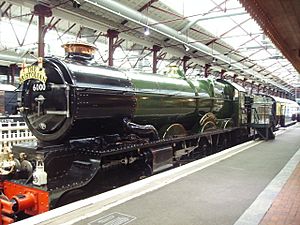
Newspapers and Magazines
Swindon has a daily newspaper called the Swindon Advertiser. It sells about 4,000 copies a day. Other newspapers include the Western Daily Press from Bristol and the Swindon Advertisers weekly paper, the Gazette and Herald. There are also many free magazines like the Wiltshire Ocelot, The Swindonian Monthly Magazine, and Swindon Link.
Swindon in Books
Swindon is the setting for the Thursday Next series of novels by Jasper Fforde. It's also where the story The Curious Incident of the Dog in the Night-Time by Mark Haddon takes place.
Radio Stations
The first commercial radio station in Swindon was Wiltshire Radio in 1982. BBC Wiltshire Sound started in 1989. Wiltshire Radio later became GWR FM, then Heart Wiltshire, and is now Heart West.
Since 2008, Swindon has had its own 24-hour community radio station, Swindon 105.5. This station won the Queen's Award for Voluntary Service in 2014, which is a very high award for volunteer groups.
Television
Swindon gets TV signals from two main areas, Oxford and Mendip. There's also a local relay transmitter in town. ITV news comes from ITV News Meridian and ITV West Country. On BBC One, you can watch South Today or Points West.
Between 1973 and 1982, Swindon even had its own cable TV channel called Swindon Viewpoint. This was a community project run by local enthusiasts.
Learning in Swindon
Swindon has many primary schools, 12 secondary schools, and two colleges for older students. Three secondary schools also have sixth forms. There is one independent school, Maranatha Christian School.
Secondary Schools
Here are some of the secondary schools in Swindon:
- Abbey Park School (ages 11–16)
- Commonweal School (11–18)
- The Dorcan Academy (11–16)
- Great Western Academy (11–18)
- Highworth Warneford School (11–16)
- Kingsdown School (11–16)
- Lawn Manor Academy (11–16)
- Lydiard Park Academy (11–18)
- Nova Hreod Academy (11–16)
- The Ridgeway School and Sixth Form College (11–18)
- St Joseph's Catholic College (11–16)
- Swindon Academy (ages 3–19, from nursery to secondary school)
- UTC Swindon (14–19)
Bradon Forest School (ages 11–18) is in Purton, near Swindon.
Further Education
New College and Swindon College offer further education. This is mainly for students aged 16 to 22. Swindon College is one of the largest colleges in southwestern England.
Higher Education
Swindon is the largest town in the UK without its own university. However, there are some university options.
Oxford Brookes University has had a campus in Swindon since 1999. It offers degrees in Adult Nursing and Operating Department Practice. The Joel Joffe Building opened in 2016. The university also supports UTC Swindon, which opened in 2014.
The Royal Agricultural University has its Cultural Heritage Institute in the old railway carriage works.
Museums and Cultural Spots
- The Richard Jefferies Museum is near Coate Water Country Park. It celebrates the writer Richard Jefferies, who wrote about nature.
- STEAM – Museum of the Great Western Railway is on the site of the old railway works.
- Lydiard House, in Lydiard Country Park, is a beautiful house with old furniture and art.
- The Local Studies Collection at Swindon Central Library has many old documents and family history records.
- Swindon Arts Centre is a small entertainment venue in Old Town.
- The Wyvern Theatre is the town's main stage for performances.
- Museum & Art Swindon has collections about local history, archaeology, and natural history. It also has a great collection of modern British art.
- The Museum of Computing was the first computer museum in the UK.
- The Science Museum's National Collections Centre is nearby at Wroughton.
- The Bodleian Library's Book Storage Facility is at South Marston.
Sports in Swindon
Football
Swindon Town F.C. is based at the County Ground in the town center. They play in League Two, which is the fourth level of English football. The women's team, Swindon Town W.F.C., plays their home games outside of town.
Swindon also has a non-league club called Swindon Supermarine F.C.. They play in the Southern League at their South Marston ground.
Rugby
Swindon has three rugby union teams: Swindon Rugby Football Club, Swindon College Old Boys Rugby Football Club, and Supermarine Rugby Football Club.
Swindon St George is a rugby league team. They wear black and red shirts. The team was started in 2007.
English Rugby player Jonny May lived in Chiseldon and went to The Ridgeway School & Sixth Form College in Wroughton, both near Swindon.
Ice Hockey
The Swindon Wildcats play in the second-tier English Premier Ice Hockey League. They have played their home games at the 2,800-seat Link Centre since 1986.
Motor Sports
Swindon Robins is a speedway team. They compete in the top national division, the SGB Premiership. They were champions in 2017. The team has raced at the Abbey Stadium in Blunsdon since 1949.
Foxhill motocross circuit is about 6 km southeast of Swindon. It has hosted big motocross events.
Athletics
Swindon has two athletics clubs: Swindon Harriers (for running and track and field) and Swindon Striders (for running). There are also two Hash House Harriers running groups in Swindon. A parkrun is held every Saturday at Lydiard Country Park.
Climbing
Swindon Mountaineering Club is for people who enjoy walking, rock climbing, and mountaineering. Members train on an indoor climbing wall at the Rockstar Climbing Centre in Swindon.
Famous People from Swindon
- Dean Ashton, a former England international footballer.
- Julian Clary, a stand-up comedian.
- Rick Davies, singer and keyboardist from the band Supertramp.
- Diana Dors, an actor.
- Justin Hayward, lead singer and guitarist in The Moody Blues.
- Nick Hewer, a businessman and TV presenter.
- Mark Lamarr, a comedian and TV presenter.
- Meat Beat Manifesto, an electronic music group formed in Swindon.
- Melinda Messenger, a TV presenter.
- Edith New, a suffragette.
- Rachel Shelley, an actor.
- Gilbert O'Sullivan, an Irish-born singer-songwriter who grew up in Swindon.
- Billie Piper, an actor.
- Jon Richardson, a stand-up comedian.
- Ben Thatcher, a former Premier League footballer for Wales.
- XTC, a post-punk band formed in Swindon in 1972.
- Max Cook, a motorcycle racer.
- Charlie Nesbitt, a motorcycle racer.
- Fraser Rogers, a motorcycle racer.
Sister Cities
Swindon has "twin towns" or "sister cities" around the world. This means they have special friendly relationships.
- Salzgitter, Germany
- Ocotal, Nicaragua
- Toruń, Poland
- Disney World, United States
Images for kids
See also
 In Spanish: Swindon para niños
In Spanish: Swindon para niños



